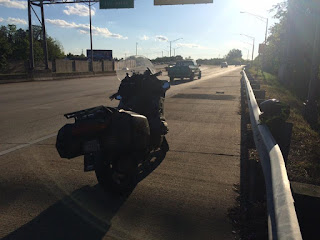Every rider I know subscribes to at least a few of the literary - or nonliterary if you prefer glossy pinups over the printed word - rags featuring the two-wheeled life. In the months preceding the holidays, each of these periodicals features sections previewing gifts suitable for the bikers in our lives. Write-ups reviewing everything from heated gear to the best cloth for polishing chrome compound these wondrous wish-lists. I sort these reviews according to my own criteria as well. I often skip to the end of each article for those obligatory price listings. Anything with the tag "call for pricing" typically moves to the bottom of the list. Items under 50 bucks gravitate toward the number one spot. Over the past few years, few suggested gifts capture my attention in a way that moves the item into the "must-have" category.
In the past few years, my tastes in motorcycle gear that contributes to the enjoyment of riding have simplified in many respects. Gear which requires the same ingenuity as a Chinese puzzle to enter and exit falls to the bottom of the list. I favor protection, comfort, and adaptability to suit my style of riding. As a result, the fluff tends to drop further down the list every year. While I find the concept of heads-up displays projecting speed, gear, and engine rpm onto the visor of my helmet fascinating, the price for an electronic doodad which performs the same function as the gauges with which the machine is equipped outstrips my desire for such an item. I also find most of these contraptions bulky and intrusive - nothing quite like having a half-pound of plastic hanging off my helmet to change my opinion of the terms "essential", "practical", and "safe". That being said, I rather enjoy my Sena bluetooth headset - a gift to myself last year - for the product's ease of use and integration into the helmet. I could care less about receiving calls while on the road, but righteous tunes are another matter entirely.
Despite perusing various motorcycle wish-lists and stoking the flames of desire, the best gifts - even those in the biker community - are unexpected and thoughtful. During a company Christmas party this year, I received a pair of motorcycle cuff links as a part of the company gift exchange. The gift startled me and demonstrated to me a unique sense of consideration and genuineness. I was moved to the point of a public display of emotion. Not much, mind you, I am still a rough-and-tumble biker, after all. But my astonishment did not go unnoticed by my supervisor who frequently states that I am emotionally distant in my work relationships. Being an introvert, even gifts where I least expect them must truly touch my spirit in order for me to outwardly express my amazement and gratitude.
Cuff links aren't exactly the most practical gift for a motorcyclist. They certainly wouldn't place high on my wish-list and I've never seen a review of such a gift in any of the magazines to which I subscribe. So why would a biker - more at home in black t-shirts than black ties - cherish a pair of cuff links? From the time I began riding on the street, I recall hearing nothing from non-riders except words of caution and warning. See if a few of these sound familiar: "Motorcycles are dangerous"; "I hope you wear a helmet at least"; "I knew a guy that went down and he ripped off his ...(insert appropriate body part)". People who do not ride motorcycles seem compelled to offer up nuggets of proverbial wisdom for our consumption - despite a lack of personal experience. Over the years, I've learned - like many of us for whom motorcycles emerge as central to a meaningful life - to tune out the naysayers and dire predictions.
When one of the non-motorcycling populace - without personal interest or understanding - offers a gift to a biker that reinforces our love for the two-wheeled life, the action more than the gift carries a tremendous significance in our lives. While the gift may not be practical, it reinforces the importance and centrality of the biker life as something profoundly sacred to the rider receiving the gift. In my own life, reinforcement from outside the motorcycle community is rare and, therefore, something to be honored.
I wouldn't say that the gift of motorcycle cuff links is entirely impractical. I have plenty of time to prepare for next year's Distinguished Gentlemen's Ride. Now all I need is a good shirt, sturdy trousers, vintage boots, a decent haircut, argyle socks, mustache wax......








